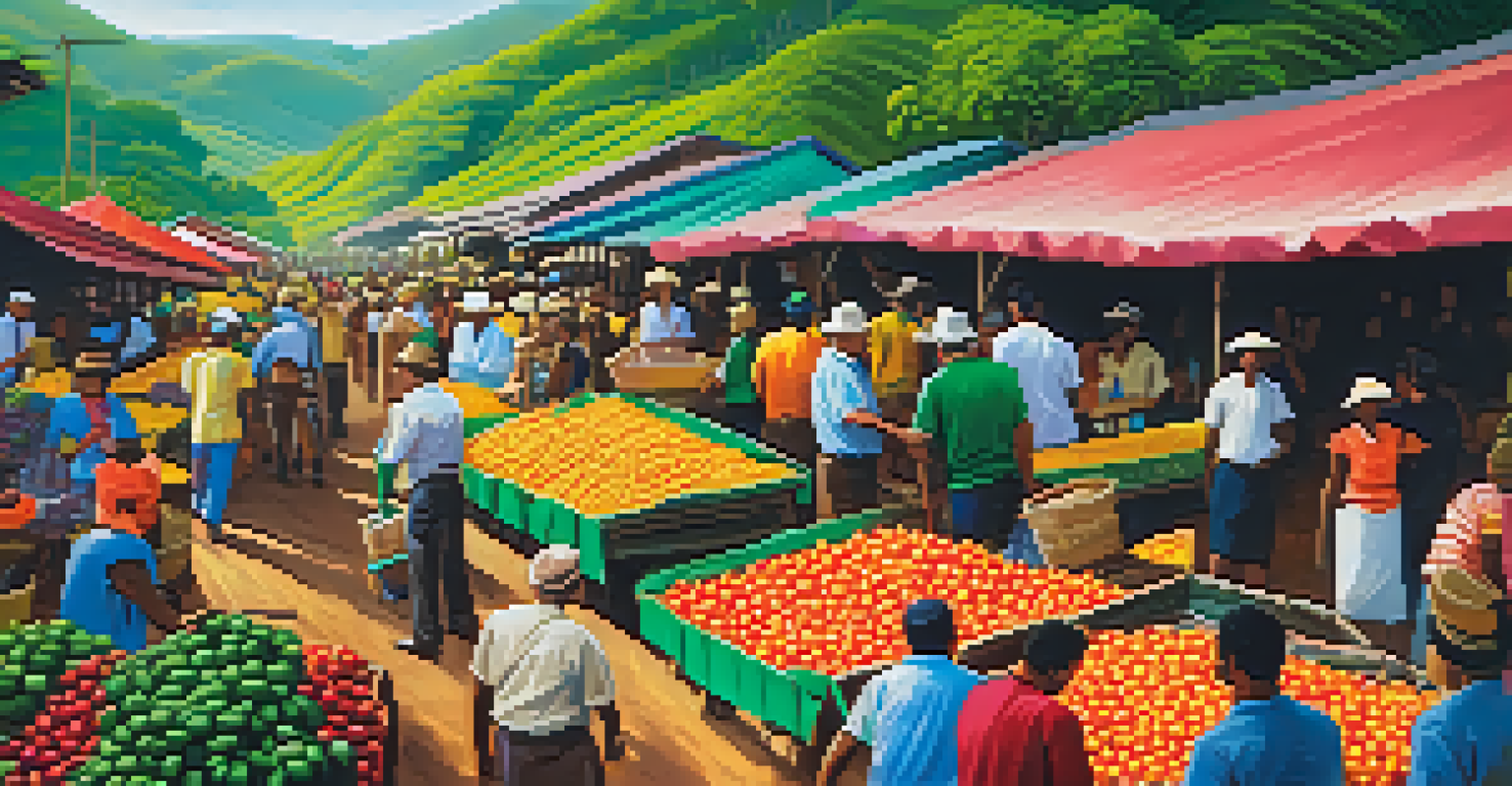From Bean to Cup: The Brazilian Coffee Journey Explained

The Rich History of Brazilian Coffee Cultivation
Brazil has a storied history with coffee, dating back to the 18th century when it was introduced from France. Over the years, it has become the largest coffee producer in the world, significantly shaping the global market. The country's diverse climate and geography allow for the cultivation of different coffee varieties, each with its unique flavor profile.
Coffee is a language in itself.
Coffee production quickly became a vital part of Brazil's economy, creating jobs and supporting local communities. As the industry grew, so did the demand for high-quality beans, leading to innovations in farming and processing techniques. Today, Brazil's coffee industry is a blend of traditional practices and modern technology, ensuring that it remains at the forefront of coffee production.
The passion for coffee in Brazil is more than just economic; it’s a cultural phenomenon. From bustling city cafes to rural farms, coffee connects people across the nation, creating a rich tapestry of traditions that celebrate this beloved beverage.
The Coffee Plant: Understanding Varieties and Growth
At the heart of the coffee journey is the coffee plant itself, primarily the Arabica and Robusta varieties grown in Brazil. Arabica beans are known for their sweeter, more nuanced flavors, while Robusta beans provide a stronger, more bitter taste. Understanding these differences is crucial for coffee lovers who seek to appreciate the subtleties in their cup.

Coffee plants thrive in specific conditions, requiring a delicate balance of altitude, temperature, and rainfall. Brazil’s varied landscapes, from the highlands to the valleys, create ideal environments for coffee growth. As the plants mature, they produce cherries that hold the precious coffee beans, ready for harvest.
Brazil: World's Coffee Leader
Brazil has evolved into the largest coffee producer globally, significantly impacting the coffee market and economy.
The journey of a coffee bean begins with careful cultivation and attention to detail. Farmers often employ sustainable practices to ensure the health of the plants and the surrounding ecosystem, highlighting the importance of responsible coffee production in Brazil.
Harvesting: The Art and Timing of Picking Coffee Cherries
Harvesting coffee cherries is a labor-intensive process that can significantly affect the quality of the final product. In Brazil, the most common method is strip picking, where all cherries are harvested at once, allowing for efficient collection. However, selective picking, where only ripe cherries are harvested, can yield higher quality beans.
Life is too short to drink bad coffee.
The timing of the harvest is crucial; cherries need to be picked when they reach peak ripeness, which varies depending on the region and weather conditions. Farmers often rely on their experience and knowledge of the land to determine the optimal time for harvesting. This careful attention to detail ensures that only the best cherries make it to the next stage of production.
Once harvested, the cherries are quickly transported to processing facilities to prevent spoilage. The swift transition from tree to processing is essential for maintaining the quality and flavor profile of Brazilian coffee.
Processing Methods: Transforming Cherries into Green Beans
Processing coffee cherries is a critical step in the journey from bean to cup. In Brazil, two primary methods are used: the dry method and the wet method. The dry method involves spreading cherries out in the sun to dry, while the wet method uses water to remove the fruit before drying the beans, each imparting different flavors to the final product.
The choice of processing method can significantly impact the beans' quality and taste. For example, the dry method tends to produce a more fruity and complex flavor, while the wet method results in cleaner and brighter profiles. This diversity allows Brazilian coffee to cater to a wide range of palates.
Coffee Cultivation and Varieties
The Arabica and Robusta coffee varieties thrive in Brazil's diverse climate, each offering unique flavor profiles for coffee enthusiasts.
After processing, the beans are hulled, graded, and sorted based on size and quality. This meticulous attention to detail ensures that only the finest beans are selected for roasting, setting the stage for the final journey to your cup.
Roasting: The Transformation of Green Beans into Coffee
Roasting is where the magic happens, transforming green coffee beans into the rich, aromatic coffee we love. In Brazil, roasters use various techniques to develop unique flavor profiles, often experimenting with different roast levels to highlight the beans' characteristics. Light roasts can bring out bright acidity, while darker roasts can create deep, rich flavors.
The roasting process involves heating the beans to specific temperatures, causing complex chemical reactions that enhance their flavor. Roasters carefully monitor the time and temperature to achieve the desired roast level, resulting in a wide range of flavors and aromas. This stage is crucial as it influences the final taste in your cup.
After roasting, the beans are cooled and packaged, ready to be shipped to cafes and homes around the world. The artistry of roasting is a vital part of the Brazilian coffee journey, ensuring that each cup tells the story of its unique origins.
Brewing: Enjoying the Fruits of the Coffee Journey
Brewing is the final step in the coffee journey, where all the hard work of the farmers, processors, and roasters culminates in a delicious cup. There are countless methods to brew coffee, from traditional espresso machines to pour-over techniques, each offering a different experience. The choice of brewing method can greatly influence the flavor and strength of your coffee.
Water quality, temperature, and brewing time all play essential roles in extracting the best flavors from the coffee beans. For Brazilian coffee, which often has a full-bodied profile, methods like French press or Aeropress can highlight its rich taste. Experimenting with different brewing techniques can lead to delightful discoveries.
Cultural Significance of Coffee
In Brazil, coffee is a vital cultural element that fosters social connections and reflects regional traditions and lifestyles.
Ultimately, brewing is as much about personal preference as it is about technique. Whether you enjoy a robust cup in the morning or a delicate brew in the afternoon, understanding your coffee journey enhances your appreciation for this beloved beverage.
The Cultural Significance of Coffee in Brazil
Coffee in Brazil is more than just a drink; it's a cultural cornerstone that brings people together. From lively social gatherings to quiet moments of reflection, coffee plays a vital role in daily life. The Brazilian coffee ritual often includes sharing stories and laughter over a cup, fostering connections and camaraderie.
Throughout the country, you'll find diverse coffee traditions, from the strong espresso served in urban cafes to the sweet, milky coffee enjoyed in rural homes. Each region has its unique way of preparing and savoring coffee, reflecting the local culture and lifestyle. This diversity makes Brazilian coffee a rich tapestry of flavors and experiences.

As globalization continues to influence coffee culture, Brazil remains a key player in shaping trends and standards. The country's dedication to quality and sustainability ensures that Brazilian coffee will continue to be celebrated and enjoyed for generations to come.